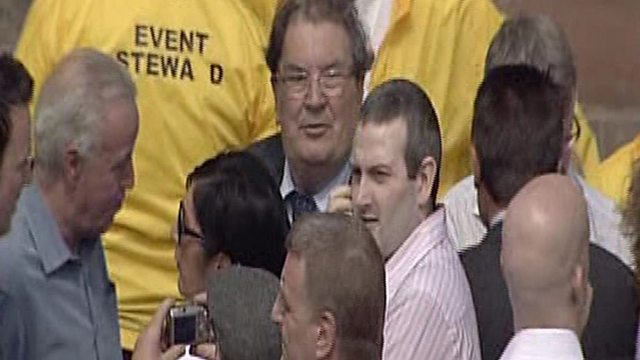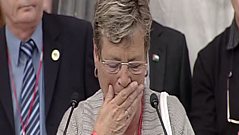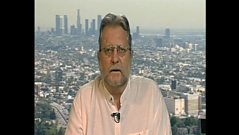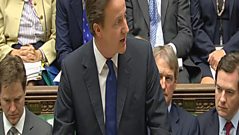
Publication of Saville Report
As an expectant crowd gathers in Londonderry’s Guildhall Square, Jim Fitzpatrick, Denis Murray and Mark Devenport speculate on the imminent publication of Lord Saville’s Bloody Sunday report.
The programme begins with an aerial shot of Guildhall Square in Londonderry where thousands are gathered to witness the publication of Lord Saville’s report into the events of Bloody Sunday (please see context below). Relatives of the victims are inside the Guildhall reading the report.
The Saville Inquiry has been the longest and most expensive public inquiry in British legal history. The previous inquiry carried out by Lord Widgery in 1972 was viewed by the relatives of the victims and the nationalist community as a ‘whitewash’.
Jim Fitzpatrick presents this special programme from the ��������’s studio at Stormont. He is joined by the ��������’s former Ireland Correspondent, Denis Murray. Denis reflects on public shock across the world at the time of the events: “Nobody expected something like that to happen in a corner of the United Kingdom”.
Denis states that the events of Bloody Sunday would have expanded the ranks of the Provisional Irish Republican Army (PIRA). Jim Fitzpatrick points out that the PIRA were in the ascendancy after Bloody Sunday, gaining more support than their fellow republicans in the Official IRA. 1972 was the worst year of the Troubles in terms of the numbers killed.
Denis states that Derry was an even smaller city in 1972 than it is now and that everyone seemed to know everyone else: “It was almost like the heart had been torn out of the city”.
Denis recalls that the relatives were initially sceptical of Lord Saville, but by the time he had taken all their statements they felt he had done the best he could: “The one thing you cannot fault that inquiry for is thoroughness”.
Jim and Denis are joined by ��������NI’s Political Editor, Mark Devenport in Guildhall Square. Mark describes the sense of anticipation in the crowd and their expectation that they will see vindication for the victims. There is also speculation regarding what the report will say about the Deputy First Minister Martin McGuinness who was PIRA’s second in command in Derry on Bloody Sunday.
John Hume is seen in the crowd.
Mark touches on the controversy surrounding Jonathan Powell’s memoirs; Powell was Tony Blair’s Chief of Staff and he claims that Martin McGuinness told him that an apology would have been sufficient. Mr. McGuinness strongly denies this claim.
Mark reflects that the inquiry helped bind nationalists into the Peace Process.
Back in the Stormont studio Denis Murray speculates that the government did not expect the inquiry to take so long or cost so much; this probably means that there will never be another inquiry of its kind.
Denis recalls that Lord Saville upbraided Martin McGuinness during the inquiry, saying that he had not helped it. McGuinness used the same defence as the soldiers; he was circumspect about what he said out of fear of incriminating himself. If there is any criticism of Martin McGuinness in the report the DUP will seize on this.
Denis does not think that the report will heal any wounds nor does he believe there will be any prosecutions as it will be too difficult to tie an individual soldier to an individual death.
CONTEXT
On 30 January 1972 soldiers from the 1st Parachute Regiment killed 13 innocent civil rights demonstrators in Derry.
The period from August 1971 to January 1972 saw a sustained campaign of anti-internment protests. On 22 January, John Hume led an illegal demonstration along Magilligan Strand just outside Londonderry, towards a nearby internment camp. The marchers were confronted by soldiers of the 1st Parachute Regiment who drove them off the beach using baton charges and rubber bullets.
It was these same paratroopers who were sent into Derry eight days later to deal with another banned protest. This march was organised by the Northern Ireland Civil Rights Association (NICRA). Some ten thousand people gathered in the Creggan estate and proceeded towards Guildhall Square in the centre of the city. The paratroopers had sealed off the approaches to the Square and the march organisers, in order to avoid trouble, led most of the demonstrators towards Free Derry Corner in the Bogside.
Groups of local youths (referred to by the security forces as ‘YDHs’ – Young Derry Hooligans) stayed behind at the Army barricades to confront the soldiers. The soldiers were ordered to move in and arrest as many of the rioters as possible. Just after four o'clock, the paratroopers made their move. What took place next was totally unexpected: the paratroopers opened fire on the crowd, killing thirteen men and injuring thirteen others; one of the injured died some time later.
The soldiers claimed that they had been fired on as they moved in to make arrests. As far as the people of the Bogside and further afield were concerned, the Army had summarily executed thirteen unarmed, innocent civilians. The Widgery Tribunal, which had been set up to investigate the circumstances surrounding the killings, later concluded that: ‘At one end of the scale, some soldiers showed a high degree of responsibility; at the other end.... firing bordered on the reckless’.
The Londonderry Coroner, Major Hubert O'Neill, did not share Lord Widgery's conclusion. At the end of the inquest in 1973, which is still seen by nationalists as a cover up for murder, O'Neill said, “It strikes me that the army ran amok that day and they shot without thinking what they were doing… I say it without reservation - it was sheer unadulterated murder”.
The British government later made out-of-court settlements with the bereaved families
In 1998 the Labour government launched an in-depth investigation chaired by Lord Saville of Newdigate. The Saville Inquiry, which was the most expensive investigation of its kind in the United Kingdom, reported in June 2010.
It concluded that none of the dead posed a threat and the actions of the soldiers were totally without justification. The Prime Minister David Cameron apologised on behalf of the nation for the “unjustified and unjustifiable killings”.
Duration:
This clip is from
More clips from Stormont Live Special - The Saville Inquiry Report
-
![]()
Relatives of Bloody Sunday victims
Duration: 27:09
-
![]()
Early political reaction to the Saville report
Duration: 09:16
-
![]()
Interview with Tony Clarke
Duration: 03:41
-
![]()
David Cameron responds to the Saville Report
Duration: 14:46





